Analysis of Emergency Services: Legislation, Roles, JESIP Procedures
VerifiedAdded on 2023/01/12
|11
|3153
|55
Report
AI Summary
This report provides an analysis of the incident management framework and response procedures within the context of emergency services. It begins by outlining current legislation, including the Civil Contingencies Act 2004, and details the roles and responsibilities of various agencies such as the Police, Fire, NHS, and Military. The report identifies responsibilities based on the Joint Emergency Services Interoperability Principles (JESIP), particularly highlighting its application in the context of a major incident like the 2019 flooding. The analysis covers key aspects of JESIP, including co-location, communication, coordination, risk understanding, and situational awareness, emphasizing their importance in effective incident management. The report concludes with a discussion on the roles of public service agencies during the incident, detailing their actions and objectives in ensuring public safety and welfare.
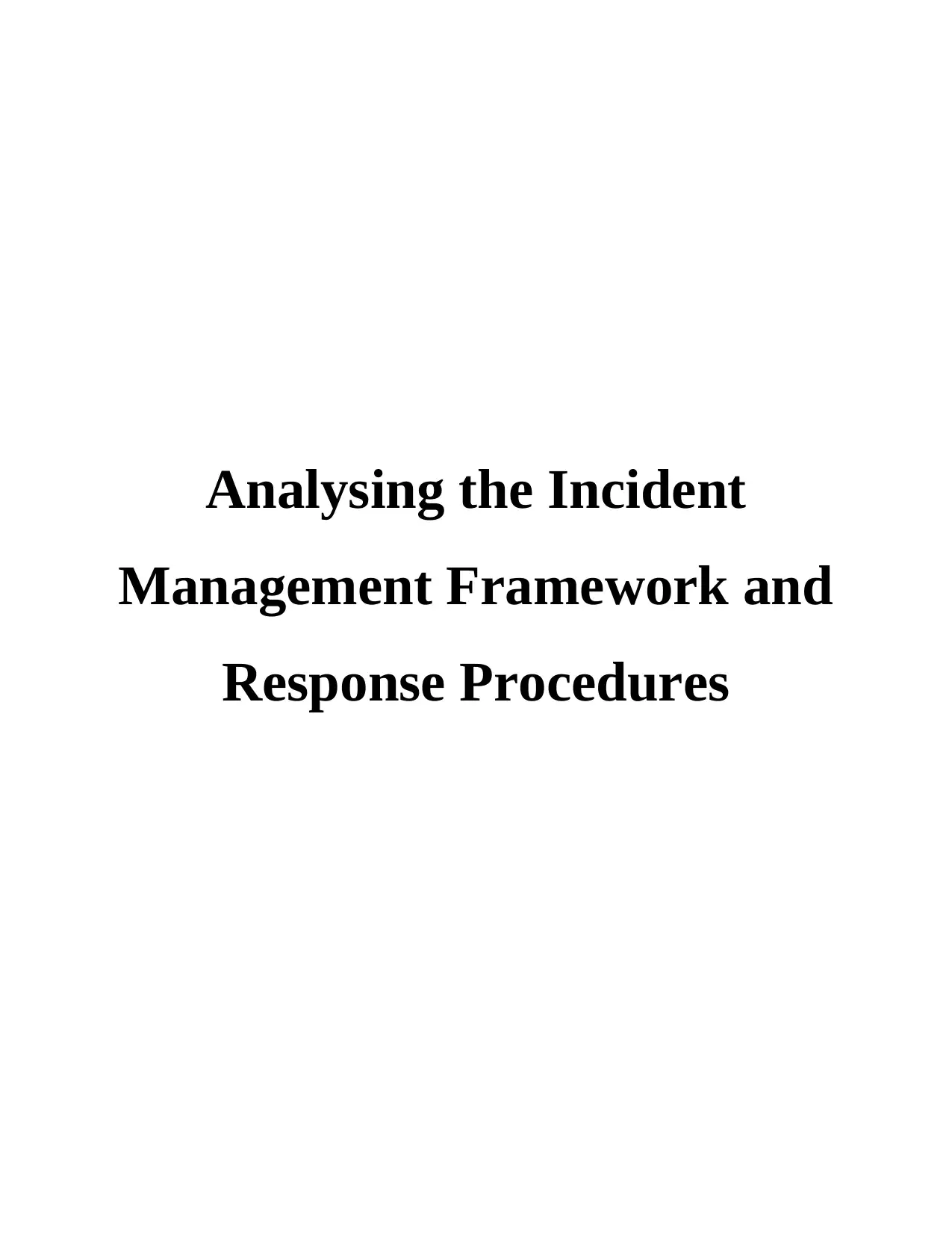
Analysing the Incident
Management Framework and
Response Procedures
Management Framework and
Response Procedures
Paraphrase This Document
Need a fresh take? Get an instant paraphrase of this document with our AI Paraphraser
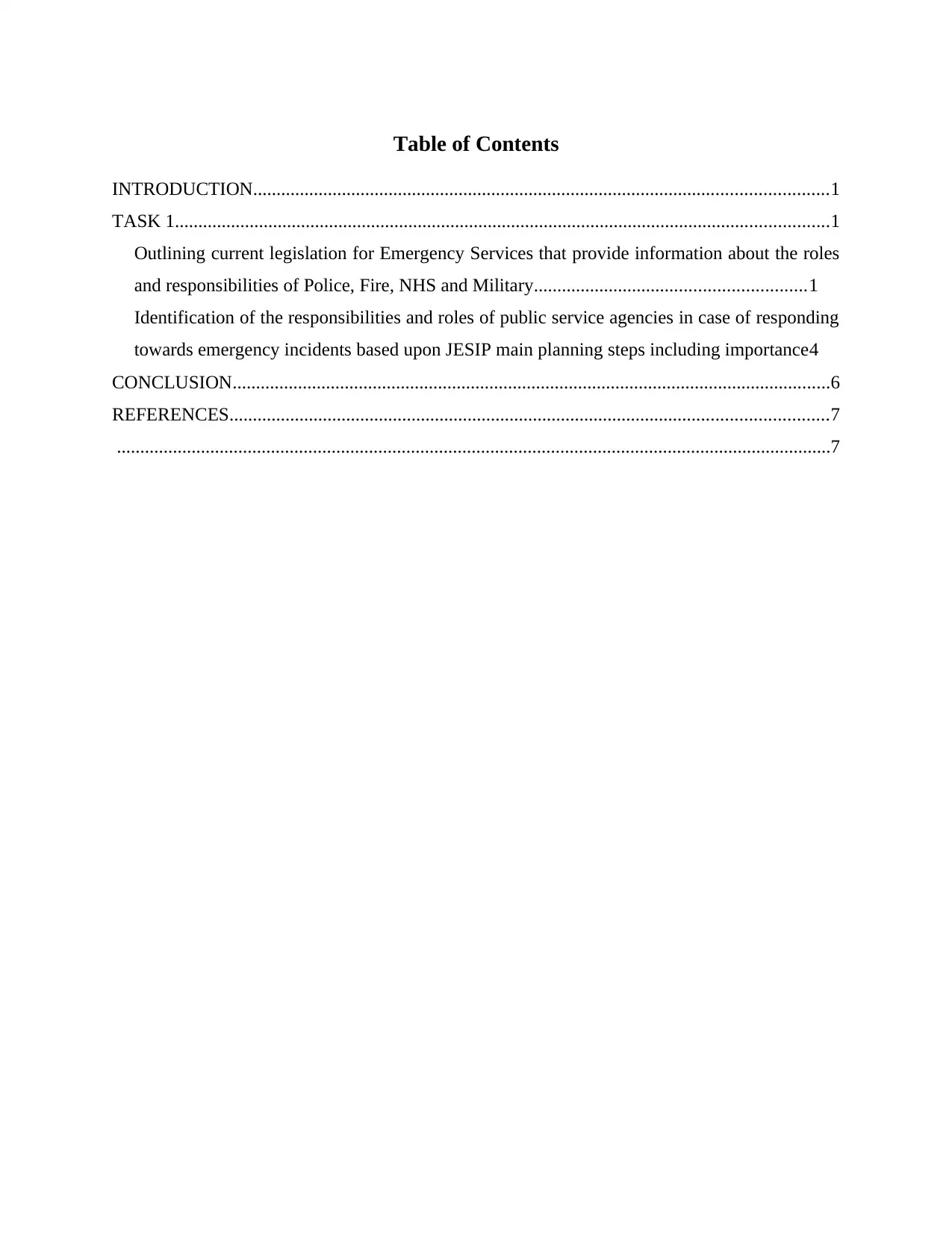
Table of Contents
INTRODUCTION...........................................................................................................................1
TASK 1............................................................................................................................................1
Outlining current legislation for Emergency Services that provide information about the roles
and responsibilities of Police, Fire, NHS and Military..........................................................1
Identification of the responsibilities and roles of public service agencies in case of responding
towards emergency incidents based upon JESIP main planning steps including importance4
CONCLUSION................................................................................................................................6
REFERENCES................................................................................................................................7
.........................................................................................................................................................7
INTRODUCTION...........................................................................................................................1
TASK 1............................................................................................................................................1
Outlining current legislation for Emergency Services that provide information about the roles
and responsibilities of Police, Fire, NHS and Military..........................................................1
Identification of the responsibilities and roles of public service agencies in case of responding
towards emergency incidents based upon JESIP main planning steps including importance4
CONCLUSION................................................................................................................................6
REFERENCES................................................................................................................................7
.........................................................................................................................................................7

⊘ This is a preview!⊘
Do you want full access?
Subscribe today to unlock all pages.

Trusted by 1+ million students worldwide
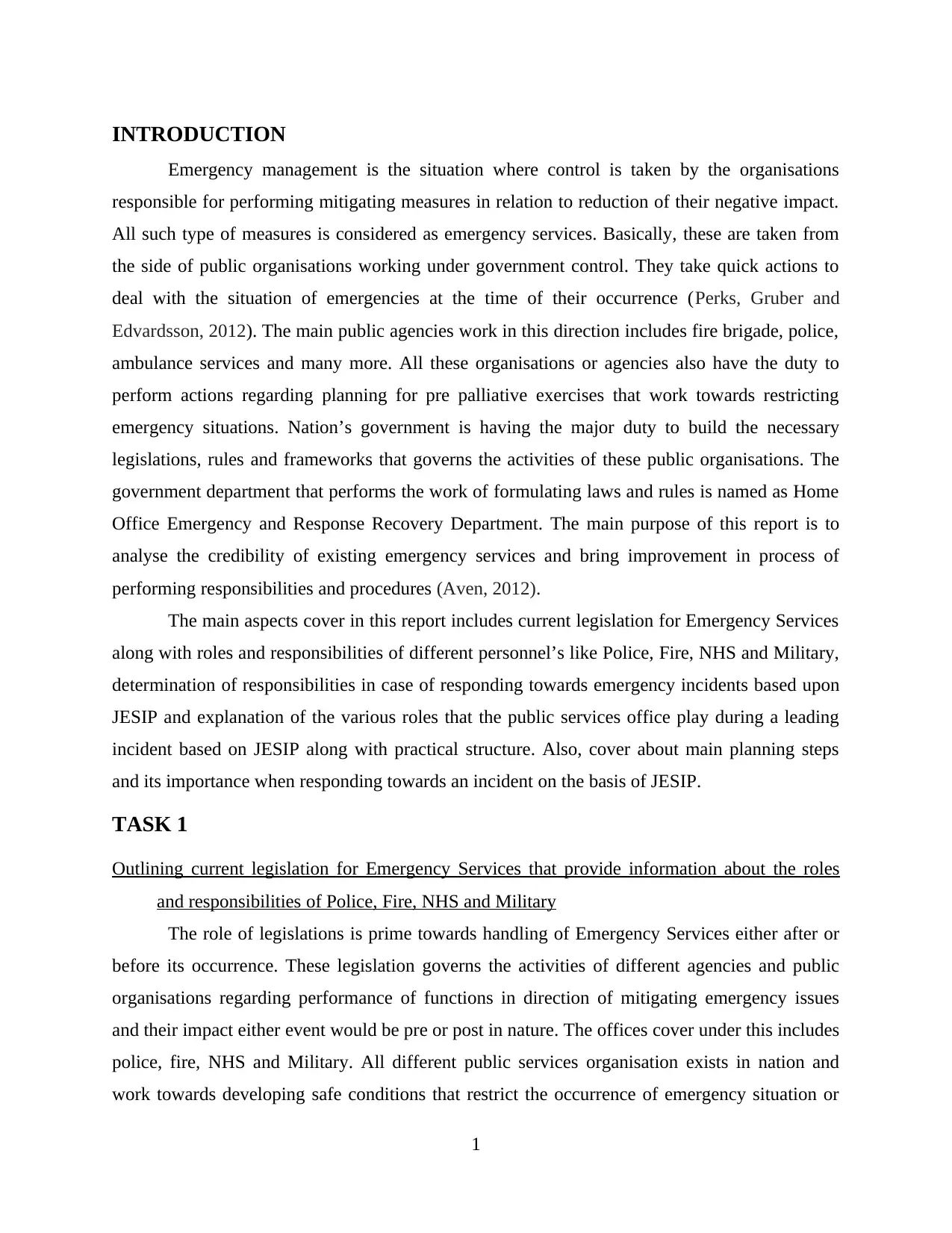
INTRODUCTION
Emergency management is the situation where control is taken by the organisations
responsible for performing mitigating measures in relation to reduction of their negative impact.
All such type of measures is considered as emergency services. Basically, these are taken from
the side of public organisations working under government control. They take quick actions to
deal with the situation of emergencies at the time of their occurrence (Perks, Gruber and
Edvardsson, 2012). The main public agencies work in this direction includes fire brigade, police,
ambulance services and many more. All these organisations or agencies also have the duty to
perform actions regarding planning for pre palliative exercises that work towards restricting
emergency situations. Nation’s government is having the major duty to build the necessary
legislations, rules and frameworks that governs the activities of these public organisations. The
government department that performs the work of formulating laws and rules is named as Home
Office Emergency and Response Recovery Department. The main purpose of this report is to
analyse the credibility of existing emergency services and bring improvement in process of
performing responsibilities and procedures (Aven, 2012).
The main aspects cover in this report includes current legislation for Emergency Services
along with roles and responsibilities of different personnel’s like Police, Fire, NHS and Military,
determination of responsibilities in case of responding towards emergency incidents based upon
JESIP and explanation of the various roles that the public services office play during a leading
incident based on JESIP along with practical structure. Also, cover about main planning steps
and its importance when responding towards an incident on the basis of JESIP.
TASK 1
Outlining current legislation for Emergency Services that provide information about the roles
and responsibilities of Police, Fire, NHS and Military
The role of legislations is prime towards handling of Emergency Services either after or
before its occurrence. These legislation governs the activities of different agencies and public
organisations regarding performance of functions in direction of mitigating emergency issues
and their impact either event would be pre or post in nature. The offices cover under this includes
police, fire, NHS and Military. All different public services organisation exists in nation and
work towards developing safe conditions that restrict the occurrence of emergency situation or
1
Emergency management is the situation where control is taken by the organisations
responsible for performing mitigating measures in relation to reduction of their negative impact.
All such type of measures is considered as emergency services. Basically, these are taken from
the side of public organisations working under government control. They take quick actions to
deal with the situation of emergencies at the time of their occurrence (Perks, Gruber and
Edvardsson, 2012). The main public agencies work in this direction includes fire brigade, police,
ambulance services and many more. All these organisations or agencies also have the duty to
perform actions regarding planning for pre palliative exercises that work towards restricting
emergency situations. Nation’s government is having the major duty to build the necessary
legislations, rules and frameworks that governs the activities of these public organisations. The
government department that performs the work of formulating laws and rules is named as Home
Office Emergency and Response Recovery Department. The main purpose of this report is to
analyse the credibility of existing emergency services and bring improvement in process of
performing responsibilities and procedures (Aven, 2012).
The main aspects cover in this report includes current legislation for Emergency Services
along with roles and responsibilities of different personnel’s like Police, Fire, NHS and Military,
determination of responsibilities in case of responding towards emergency incidents based upon
JESIP and explanation of the various roles that the public services office play during a leading
incident based on JESIP along with practical structure. Also, cover about main planning steps
and its importance when responding towards an incident on the basis of JESIP.
TASK 1
Outlining current legislation for Emergency Services that provide information about the roles
and responsibilities of Police, Fire, NHS and Military
The role of legislations is prime towards handling of Emergency Services either after or
before its occurrence. These legislation governs the activities of different agencies and public
organisations regarding performance of functions in direction of mitigating emergency issues
and their impact either event would be pre or post in nature. The offices cover under this includes
police, fire, NHS and Military. All different public services organisation exists in nation and
work towards developing safe conditions that restrict the occurrence of emergency situation or
1
Paraphrase This Document
Need a fresh take? Get an instant paraphrase of this document with our AI Paraphraser
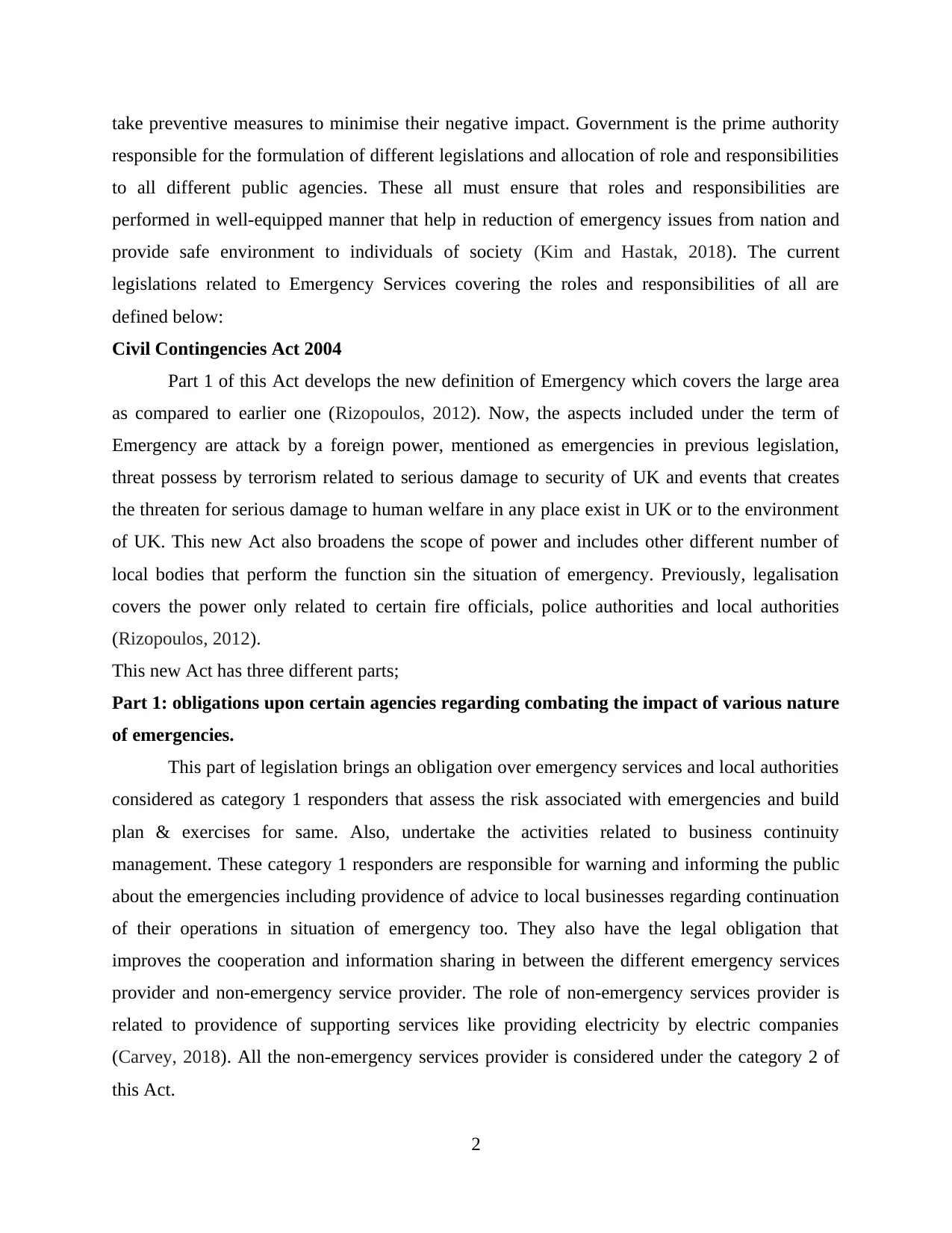
take preventive measures to minimise their negative impact. Government is the prime authority
responsible for the formulation of different legislations and allocation of role and responsibilities
to all different public agencies. These all must ensure that roles and responsibilities are
performed in well-equipped manner that help in reduction of emergency issues from nation and
provide safe environment to individuals of society (Kim and Hastak, 2018). The current
legislations related to Emergency Services covering the roles and responsibilities of all are
defined below:
Civil Contingencies Act 2004
Part 1 of this Act develops the new definition of Emergency which covers the large area
as compared to earlier one (Rizopoulos, 2012). Now, the aspects included under the term of
Emergency are attack by a foreign power, mentioned as emergencies in previous legislation,
threat possess by terrorism related to serious damage to security of UK and events that creates
the threaten for serious damage to human welfare in any place exist in UK or to the environment
of UK. This new Act also broadens the scope of power and includes other different number of
local bodies that perform the function sin the situation of emergency. Previously, legalisation
covers the power only related to certain fire officials, police authorities and local authorities
(Rizopoulos, 2012).
This new Act has three different parts;
Part 1: obligations upon certain agencies regarding combating the impact of various nature
of emergencies.
This part of legislation brings an obligation over emergency services and local authorities
considered as category 1 responders that assess the risk associated with emergencies and build
plan & exercises for same. Also, undertake the activities related to business continuity
management. These category 1 responders are responsible for warning and informing the public
about the emergencies including providence of advice to local businesses regarding continuation
of their operations in situation of emergency too. They also have the legal obligation that
improves the cooperation and information sharing in between the different emergency services
provider and non-emergency service provider. The role of non-emergency services provider is
related to providence of supporting services like providing electricity by electric companies
(Carvey, 2018). All the non-emergency services provider is considered under the category 2 of
this Act.
2
responsible for the formulation of different legislations and allocation of role and responsibilities
to all different public agencies. These all must ensure that roles and responsibilities are
performed in well-equipped manner that help in reduction of emergency issues from nation and
provide safe environment to individuals of society (Kim and Hastak, 2018). The current
legislations related to Emergency Services covering the roles and responsibilities of all are
defined below:
Civil Contingencies Act 2004
Part 1 of this Act develops the new definition of Emergency which covers the large area
as compared to earlier one (Rizopoulos, 2012). Now, the aspects included under the term of
Emergency are attack by a foreign power, mentioned as emergencies in previous legislation,
threat possess by terrorism related to serious damage to security of UK and events that creates
the threaten for serious damage to human welfare in any place exist in UK or to the environment
of UK. This new Act also broadens the scope of power and includes other different number of
local bodies that perform the function sin the situation of emergency. Previously, legalisation
covers the power only related to certain fire officials, police authorities and local authorities
(Rizopoulos, 2012).
This new Act has three different parts;
Part 1: obligations upon certain agencies regarding combating the impact of various nature
of emergencies.
This part of legislation brings an obligation over emergency services and local authorities
considered as category 1 responders that assess the risk associated with emergencies and build
plan & exercises for same. Also, undertake the activities related to business continuity
management. These category 1 responders are responsible for warning and informing the public
about the emergencies including providence of advice to local businesses regarding continuation
of their operations in situation of emergency too. They also have the legal obligation that
improves the cooperation and information sharing in between the different emergency services
provider and non-emergency service provider. The role of non-emergency services provider is
related to providence of supporting services like providing electricity by electric companies
(Carvey, 2018). All the non-emergency services provider is considered under the category 2 of
this Act.
2
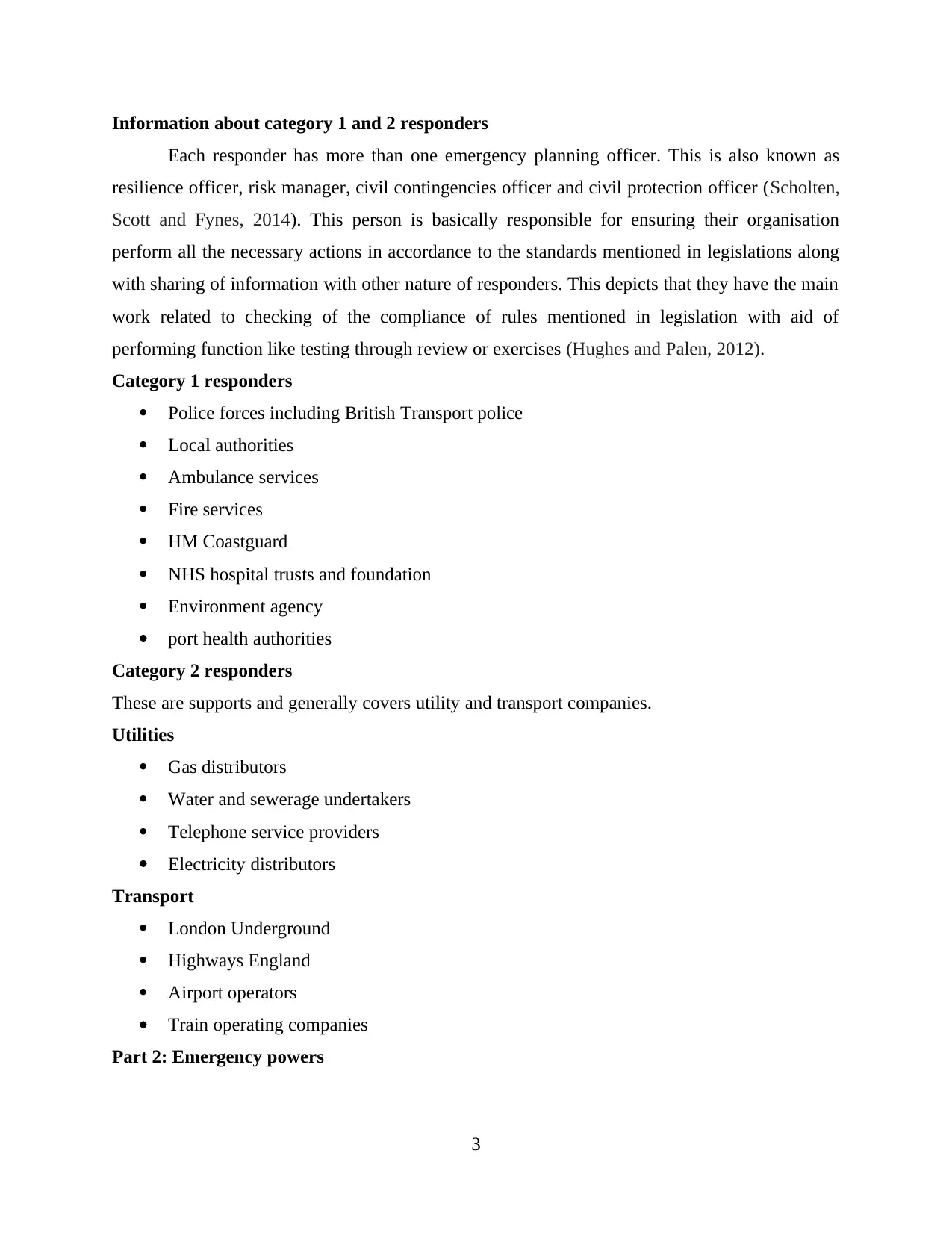
Information about category 1 and 2 responders
Each responder has more than one emergency planning officer. This is also known as
resilience officer, risk manager, civil contingencies officer and civil protection officer (Scholten,
Scott and Fynes, 2014). This person is basically responsible for ensuring their organisation
perform all the necessary actions in accordance to the standards mentioned in legislations along
with sharing of information with other nature of responders. This depicts that they have the main
work related to checking of the compliance of rules mentioned in legislation with aid of
performing function like testing through review or exercises (Hughes and Palen, 2012).
Category 1 responders
Police forces including British Transport police
Local authorities
Ambulance services
Fire services
HM Coastguard
NHS hospital trusts and foundation
Environment agency
port health authorities
Category 2 responders
These are supports and generally covers utility and transport companies.
Utilities
Gas distributors
Water and sewerage undertakers
Telephone service providers
Electricity distributors
Transport
London Underground
Highways England
Airport operators
Train operating companies
Part 2: Emergency powers
3
Each responder has more than one emergency planning officer. This is also known as
resilience officer, risk manager, civil contingencies officer and civil protection officer (Scholten,
Scott and Fynes, 2014). This person is basically responsible for ensuring their organisation
perform all the necessary actions in accordance to the standards mentioned in legislations along
with sharing of information with other nature of responders. This depicts that they have the main
work related to checking of the compliance of rules mentioned in legislation with aid of
performing function like testing through review or exercises (Hughes and Palen, 2012).
Category 1 responders
Police forces including British Transport police
Local authorities
Ambulance services
Fire services
HM Coastguard
NHS hospital trusts and foundation
Environment agency
port health authorities
Category 2 responders
These are supports and generally covers utility and transport companies.
Utilities
Gas distributors
Water and sewerage undertakers
Telephone service providers
Electricity distributors
Transport
London Underground
Highways England
Airport operators
Train operating companies
Part 2: Emergency powers
3
⊘ This is a preview!⊘
Do you want full access?
Subscribe today to unlock all pages.

Trusted by 1+ million students worldwide
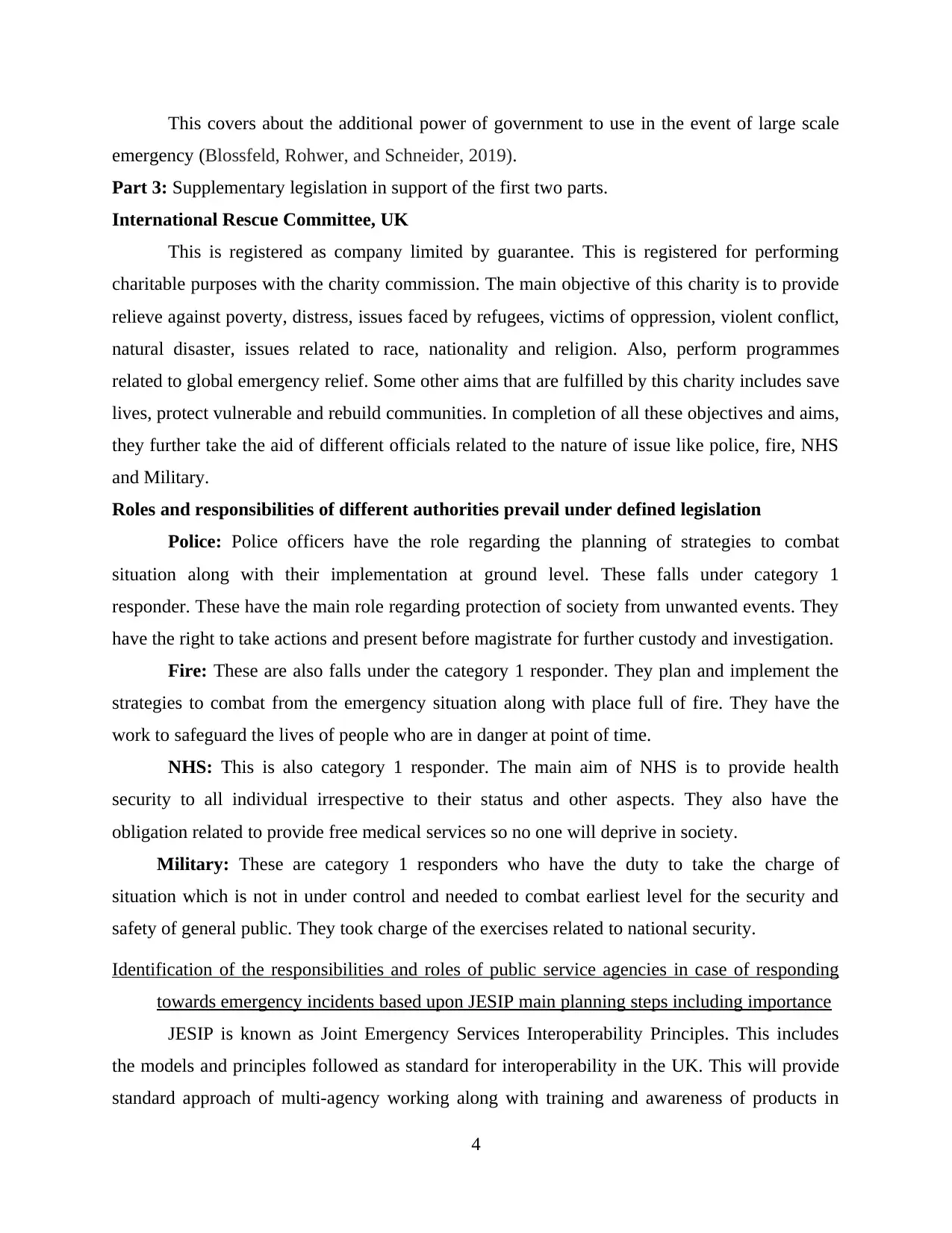
This covers about the additional power of government to use in the event of large scale
emergency (Blossfeld, Rohwer, and Schneider, 2019).
Part 3: Supplementary legislation in support of the first two parts.
International Rescue Committee, UK
This is registered as company limited by guarantee. This is registered for performing
charitable purposes with the charity commission. The main objective of this charity is to provide
relieve against poverty, distress, issues faced by refugees, victims of oppression, violent conflict,
natural disaster, issues related to race, nationality and religion. Also, perform programmes
related to global emergency relief. Some other aims that are fulfilled by this charity includes save
lives, protect vulnerable and rebuild communities. In completion of all these objectives and aims,
they further take the aid of different officials related to the nature of issue like police, fire, NHS
and Military.
Roles and responsibilities of different authorities prevail under defined legislation
Police: Police officers have the role regarding the planning of strategies to combat
situation along with their implementation at ground level. These falls under category 1
responder. These have the main role regarding protection of society from unwanted events. They
have the right to take actions and present before magistrate for further custody and investigation.
Fire: These are also falls under the category 1 responder. They plan and implement the
strategies to combat from the emergency situation along with place full of fire. They have the
work to safeguard the lives of people who are in danger at point of time.
NHS: This is also category 1 responder. The main aim of NHS is to provide health
security to all individual irrespective to their status and other aspects. They also have the
obligation related to provide free medical services so no one will deprive in society.
Military: These are category 1 responders who have the duty to take the charge of
situation which is not in under control and needed to combat earliest level for the security and
safety of general public. They took charge of the exercises related to national security.
Identification of the responsibilities and roles of public service agencies in case of responding
towards emergency incidents based upon JESIP main planning steps including importance
JESIP is known as Joint Emergency Services Interoperability Principles. This includes
the models and principles followed as standard for interoperability in the UK. This will provide
standard approach of multi-agency working along with training and awareness of products in
4
emergency (Blossfeld, Rohwer, and Schneider, 2019).
Part 3: Supplementary legislation in support of the first two parts.
International Rescue Committee, UK
This is registered as company limited by guarantee. This is registered for performing
charitable purposes with the charity commission. The main objective of this charity is to provide
relieve against poverty, distress, issues faced by refugees, victims of oppression, violent conflict,
natural disaster, issues related to race, nationality and religion. Also, perform programmes
related to global emergency relief. Some other aims that are fulfilled by this charity includes save
lives, protect vulnerable and rebuild communities. In completion of all these objectives and aims,
they further take the aid of different officials related to the nature of issue like police, fire, NHS
and Military.
Roles and responsibilities of different authorities prevail under defined legislation
Police: Police officers have the role regarding the planning of strategies to combat
situation along with their implementation at ground level. These falls under category 1
responder. These have the main role regarding protection of society from unwanted events. They
have the right to take actions and present before magistrate for further custody and investigation.
Fire: These are also falls under the category 1 responder. They plan and implement the
strategies to combat from the emergency situation along with place full of fire. They have the
work to safeguard the lives of people who are in danger at point of time.
NHS: This is also category 1 responder. The main aim of NHS is to provide health
security to all individual irrespective to their status and other aspects. They also have the
obligation related to provide free medical services so no one will deprive in society.
Military: These are category 1 responders who have the duty to take the charge of
situation which is not in under control and needed to combat earliest level for the security and
safety of general public. They took charge of the exercises related to national security.
Identification of the responsibilities and roles of public service agencies in case of responding
towards emergency incidents based upon JESIP main planning steps including importance
JESIP is known as Joint Emergency Services Interoperability Principles. This includes
the models and principles followed as standard for interoperability in the UK. This will provide
standard approach of multi-agency working along with training and awareness of products in
4
Paraphrase This Document
Need a fresh take? Get an instant paraphrase of this document with our AI Paraphraser
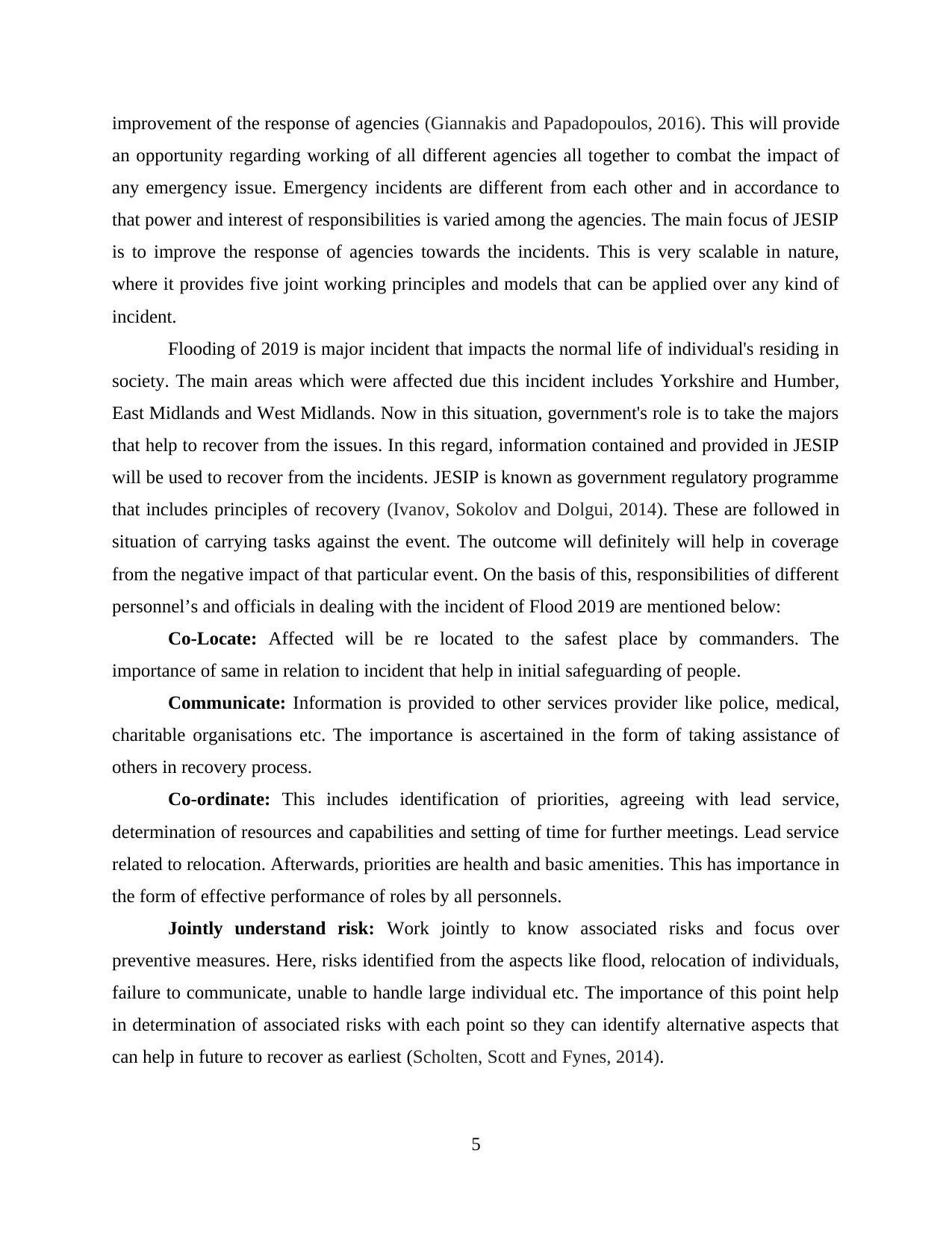
improvement of the response of agencies (Giannakis and Papadopoulos, 2016). This will provide
an opportunity regarding working of all different agencies all together to combat the impact of
any emergency issue. Emergency incidents are different from each other and in accordance to
that power and interest of responsibilities is varied among the agencies. The main focus of JESIP
is to improve the response of agencies towards the incidents. This is very scalable in nature,
where it provides five joint working principles and models that can be applied over any kind of
incident.
Flooding of 2019 is major incident that impacts the normal life of individual's residing in
society. The main areas which were affected due this incident includes Yorkshire and Humber,
East Midlands and West Midlands. Now in this situation, government's role is to take the majors
that help to recover from the issues. In this regard, information contained and provided in JESIP
will be used to recover from the incidents. JESIP is known as government regulatory programme
that includes principles of recovery (Ivanov, Sokolov and Dolgui, 2014). These are followed in
situation of carrying tasks against the event. The outcome will definitely will help in coverage
from the negative impact of that particular event. On the basis of this, responsibilities of different
personnel’s and officials in dealing with the incident of Flood 2019 are mentioned below:
Co-Locate: Affected will be re located to the safest place by commanders. The
importance of same in relation to incident that help in initial safeguarding of people.
Communicate: Information is provided to other services provider like police, medical,
charitable organisations etc. The importance is ascertained in the form of taking assistance of
others in recovery process.
Co-ordinate: This includes identification of priorities, agreeing with lead service,
determination of resources and capabilities and setting of time for further meetings. Lead service
related to relocation. Afterwards, priorities are health and basic amenities. This has importance in
the form of effective performance of roles by all personnels.
Jointly understand risk: Work jointly to know associated risks and focus over
preventive measures. Here, risks identified from the aspects like flood, relocation of individuals,
failure to communicate, unable to handle large individual etc. The importance of this point help
in determination of associated risks with each point so they can identify alternative aspects that
can help in future to recover as earliest (Scholten, Scott and Fynes, 2014).
5
an opportunity regarding working of all different agencies all together to combat the impact of
any emergency issue. Emergency incidents are different from each other and in accordance to
that power and interest of responsibilities is varied among the agencies. The main focus of JESIP
is to improve the response of agencies towards the incidents. This is very scalable in nature,
where it provides five joint working principles and models that can be applied over any kind of
incident.
Flooding of 2019 is major incident that impacts the normal life of individual's residing in
society. The main areas which were affected due this incident includes Yorkshire and Humber,
East Midlands and West Midlands. Now in this situation, government's role is to take the majors
that help to recover from the issues. In this regard, information contained and provided in JESIP
will be used to recover from the incidents. JESIP is known as government regulatory programme
that includes principles of recovery (Ivanov, Sokolov and Dolgui, 2014). These are followed in
situation of carrying tasks against the event. The outcome will definitely will help in coverage
from the negative impact of that particular event. On the basis of this, responsibilities of different
personnel’s and officials in dealing with the incident of Flood 2019 are mentioned below:
Co-Locate: Affected will be re located to the safest place by commanders. The
importance of same in relation to incident that help in initial safeguarding of people.
Communicate: Information is provided to other services provider like police, medical,
charitable organisations etc. The importance is ascertained in the form of taking assistance of
others in recovery process.
Co-ordinate: This includes identification of priorities, agreeing with lead service,
determination of resources and capabilities and setting of time for further meetings. Lead service
related to relocation. Afterwards, priorities are health and basic amenities. This has importance in
the form of effective performance of roles by all personnels.
Jointly understand risk: Work jointly to know associated risks and focus over
preventive measures. Here, risks identified from the aspects like flood, relocation of individuals,
failure to communicate, unable to handle large individual etc. The importance of this point help
in determination of associated risks with each point so they can identify alternative aspects that
can help in future to recover as earliest (Scholten, Scott and Fynes, 2014).
5
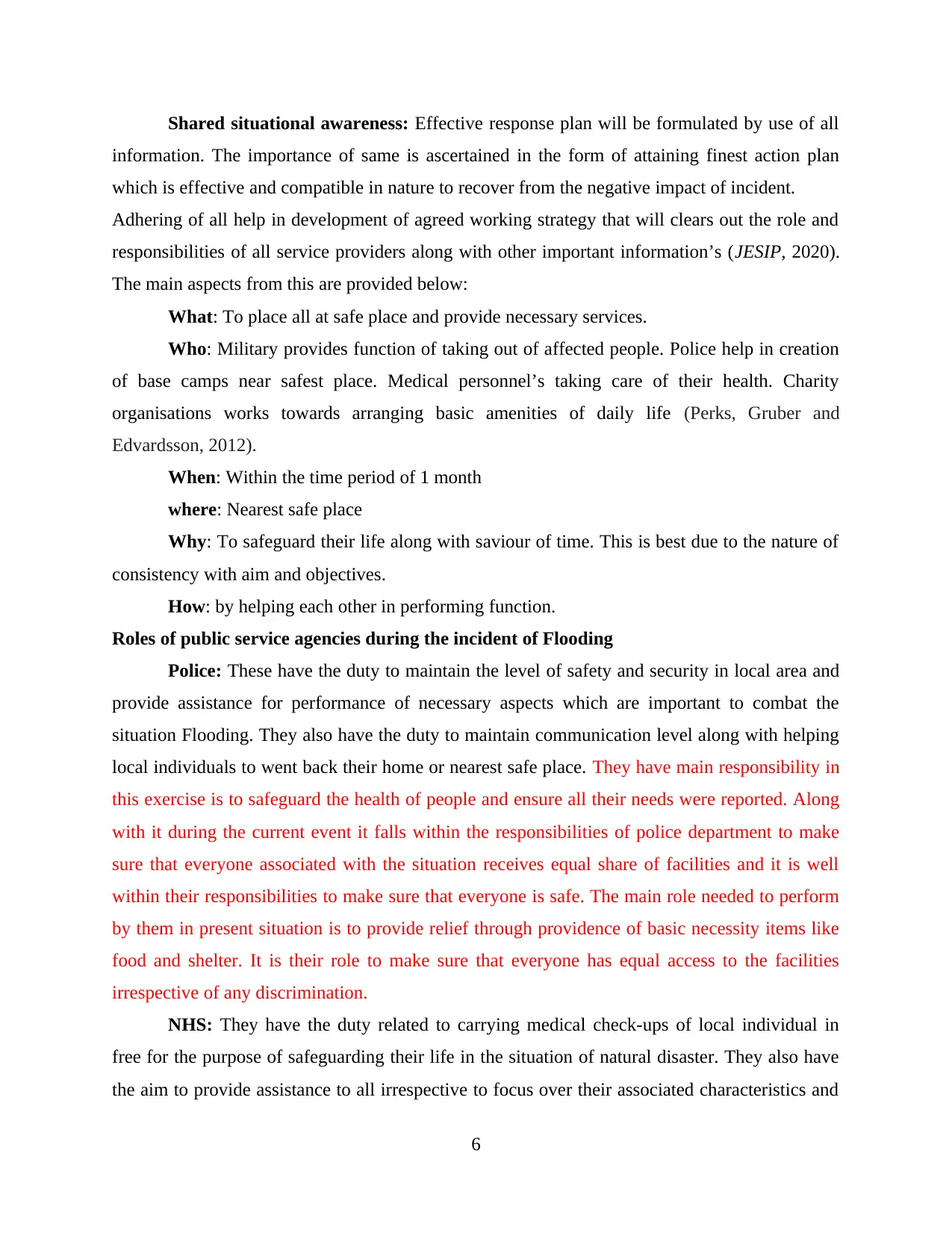
Shared situational awareness: Effective response plan will be formulated by use of all
information. The importance of same is ascertained in the form of attaining finest action plan
which is effective and compatible in nature to recover from the negative impact of incident.
Adhering of all help in development of agreed working strategy that will clears out the role and
responsibilities of all service providers along with other important information’s (JESIP, 2020).
The main aspects from this are provided below:
What: To place all at safe place and provide necessary services.
Who: Military provides function of taking out of affected people. Police help in creation
of base camps near safest place. Medical personnel’s taking care of their health. Charity
organisations works towards arranging basic amenities of daily life (Perks, Gruber and
Edvardsson, 2012).
When: Within the time period of 1 month
where: Nearest safe place
Why: To safeguard their life along with saviour of time. This is best due to the nature of
consistency with aim and objectives.
How: by helping each other in performing function.
Roles of public service agencies during the incident of Flooding
Police: These have the duty to maintain the level of safety and security in local area and
provide assistance for performance of necessary aspects which are important to combat the
situation Flooding. They also have the duty to maintain communication level along with helping
local individuals to went back their home or nearest safe place. They have main responsibility in
this exercise is to safeguard the health of people and ensure all their needs were reported. Along
with it during the current event it falls within the responsibilities of police department to make
sure that everyone associated with the situation receives equal share of facilities and it is well
within their responsibilities to make sure that everyone is safe. The main role needed to perform
by them in present situation is to provide relief through providence of basic necessity items like
food and shelter. It is their role to make sure that everyone has equal access to the facilities
irrespective of any discrimination.
NHS: They have the duty related to carrying medical check-ups of local individual in
free for the purpose of safeguarding their life in the situation of natural disaster. They also have
the aim to provide assistance to all irrespective to focus over their associated characteristics and
6
information. The importance of same is ascertained in the form of attaining finest action plan
which is effective and compatible in nature to recover from the negative impact of incident.
Adhering of all help in development of agreed working strategy that will clears out the role and
responsibilities of all service providers along with other important information’s (JESIP, 2020).
The main aspects from this are provided below:
What: To place all at safe place and provide necessary services.
Who: Military provides function of taking out of affected people. Police help in creation
of base camps near safest place. Medical personnel’s taking care of their health. Charity
organisations works towards arranging basic amenities of daily life (Perks, Gruber and
Edvardsson, 2012).
When: Within the time period of 1 month
where: Nearest safe place
Why: To safeguard their life along with saviour of time. This is best due to the nature of
consistency with aim and objectives.
How: by helping each other in performing function.
Roles of public service agencies during the incident of Flooding
Police: These have the duty to maintain the level of safety and security in local area and
provide assistance for performance of necessary aspects which are important to combat the
situation Flooding. They also have the duty to maintain communication level along with helping
local individuals to went back their home or nearest safe place. They have main responsibility in
this exercise is to safeguard the health of people and ensure all their needs were reported. Along
with it during the current event it falls within the responsibilities of police department to make
sure that everyone associated with the situation receives equal share of facilities and it is well
within their responsibilities to make sure that everyone is safe. The main role needed to perform
by them in present situation is to provide relief through providence of basic necessity items like
food and shelter. It is their role to make sure that everyone has equal access to the facilities
irrespective of any discrimination.
NHS: They have the duty related to carrying medical check-ups of local individual in
free for the purpose of safeguarding their life in the situation of natural disaster. They also have
the aim to provide assistance to all irrespective to focus over their associated characteristics and
6
⊘ This is a preview!⊘
Do you want full access?
Subscribe today to unlock all pages.

Trusted by 1+ million students worldwide
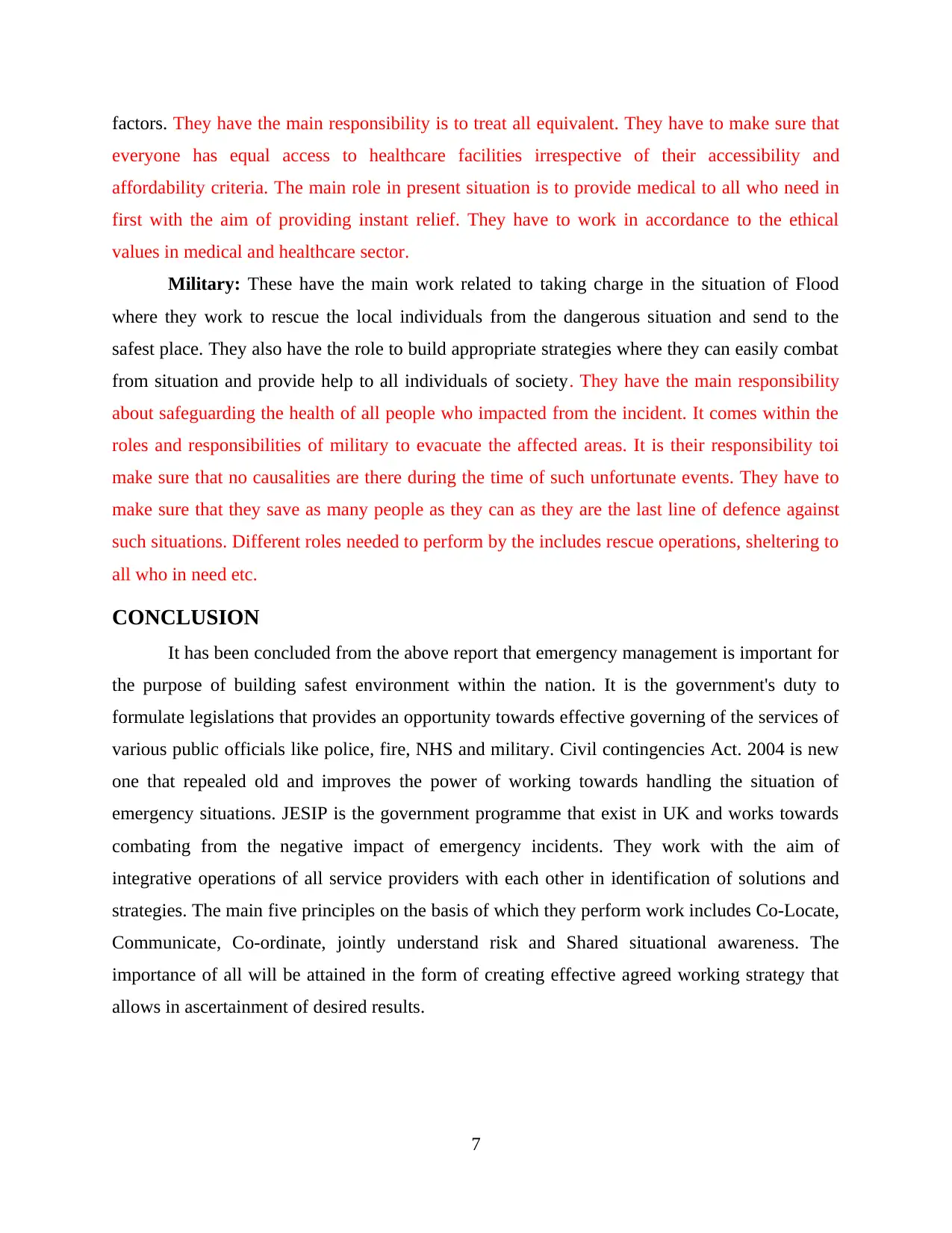
factors. They have the main responsibility is to treat all equivalent. They have to make sure that
everyone has equal access to healthcare facilities irrespective of their accessibility and
affordability criteria. The main role in present situation is to provide medical to all who need in
first with the aim of providing instant relief. They have to work in accordance to the ethical
values in medical and healthcare sector.
Military: These have the main work related to taking charge in the situation of Flood
where they work to rescue the local individuals from the dangerous situation and send to the
safest place. They also have the role to build appropriate strategies where they can easily combat
from situation and provide help to all individuals of society. They have the main responsibility
about safeguarding the health of all people who impacted from the incident. It comes within the
roles and responsibilities of military to evacuate the affected areas. It is their responsibility toi
make sure that no causalities are there during the time of such unfortunate events. They have to
make sure that they save as many people as they can as they are the last line of defence against
such situations. Different roles needed to perform by the includes rescue operations, sheltering to
all who in need etc.
CONCLUSION
It has been concluded from the above report that emergency management is important for
the purpose of building safest environment within the nation. It is the government's duty to
formulate legislations that provides an opportunity towards effective governing of the services of
various public officials like police, fire, NHS and military. Civil contingencies Act. 2004 is new
one that repealed old and improves the power of working towards handling the situation of
emergency situations. JESIP is the government programme that exist in UK and works towards
combating from the negative impact of emergency incidents. They work with the aim of
integrative operations of all service providers with each other in identification of solutions and
strategies. The main five principles on the basis of which they perform work includes Co-Locate,
Communicate, Co-ordinate, jointly understand risk and Shared situational awareness. The
importance of all will be attained in the form of creating effective agreed working strategy that
allows in ascertainment of desired results.
7
everyone has equal access to healthcare facilities irrespective of their accessibility and
affordability criteria. The main role in present situation is to provide medical to all who need in
first with the aim of providing instant relief. They have to work in accordance to the ethical
values in medical and healthcare sector.
Military: These have the main work related to taking charge in the situation of Flood
where they work to rescue the local individuals from the dangerous situation and send to the
safest place. They also have the role to build appropriate strategies where they can easily combat
from situation and provide help to all individuals of society. They have the main responsibility
about safeguarding the health of all people who impacted from the incident. It comes within the
roles and responsibilities of military to evacuate the affected areas. It is their responsibility toi
make sure that no causalities are there during the time of such unfortunate events. They have to
make sure that they save as many people as they can as they are the last line of defence against
such situations. Different roles needed to perform by the includes rescue operations, sheltering to
all who in need etc.
CONCLUSION
It has been concluded from the above report that emergency management is important for
the purpose of building safest environment within the nation. It is the government's duty to
formulate legislations that provides an opportunity towards effective governing of the services of
various public officials like police, fire, NHS and military. Civil contingencies Act. 2004 is new
one that repealed old and improves the power of working towards handling the situation of
emergency situations. JESIP is the government programme that exist in UK and works towards
combating from the negative impact of emergency incidents. They work with the aim of
integrative operations of all service providers with each other in identification of solutions and
strategies. The main five principles on the basis of which they perform work includes Co-Locate,
Communicate, Co-ordinate, jointly understand risk and Shared situational awareness. The
importance of all will be attained in the form of creating effective agreed working strategy that
allows in ascertainment of desired results.
7
Paraphrase This Document
Need a fresh take? Get an instant paraphrase of this document with our AI Paraphraser
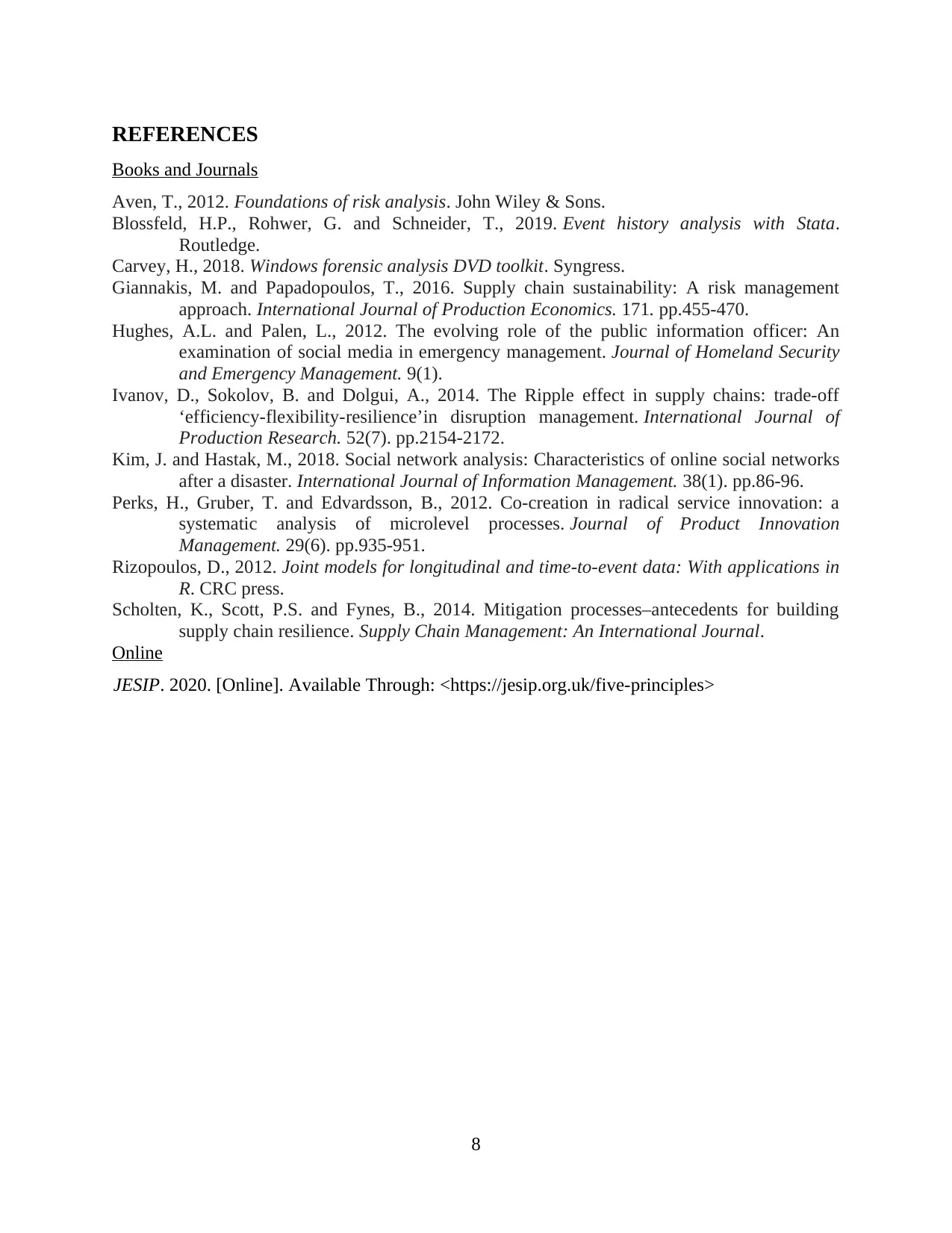
REFERENCES
Books and Journals
Aven, T., 2012. Foundations of risk analysis. John Wiley & Sons.
Blossfeld, H.P., Rohwer, G. and Schneider, T., 2019. Event history analysis with Stata.
Routledge.
Carvey, H., 2018. Windows forensic analysis DVD toolkit. Syngress.
Giannakis, M. and Papadopoulos, T., 2016. Supply chain sustainability: A risk management
approach. International Journal of Production Economics. 171. pp.455-470.
Hughes, A.L. and Palen, L., 2012. The evolving role of the public information officer: An
examination of social media in emergency management. Journal of Homeland Security
and Emergency Management. 9(1).
Ivanov, D., Sokolov, B. and Dolgui, A., 2014. The Ripple effect in supply chains: trade-off
‘efficiency-flexibility-resilience’in disruption management. International Journal of
Production Research. 52(7). pp.2154-2172.
Kim, J. and Hastak, M., 2018. Social network analysis: Characteristics of online social networks
after a disaster. International Journal of Information Management. 38(1). pp.86-96.
Perks, H., Gruber, T. and Edvardsson, B., 2012. Co‐creation in radical service innovation: a
systematic analysis of microlevel processes. Journal of Product Innovation
Management. 29(6). pp.935-951.
Rizopoulos, D., 2012. Joint models for longitudinal and time-to-event data: With applications in
R. CRC press.
Scholten, K., Scott, P.S. and Fynes, B., 2014. Mitigation processes–antecedents for building
supply chain resilience. Supply Chain Management: An International Journal.
Online
JESIP. 2020. [Online]. Available Through: <https://jesip.org.uk/five-principles>
8
Books and Journals
Aven, T., 2012. Foundations of risk analysis. John Wiley & Sons.
Blossfeld, H.P., Rohwer, G. and Schneider, T., 2019. Event history analysis with Stata.
Routledge.
Carvey, H., 2018. Windows forensic analysis DVD toolkit. Syngress.
Giannakis, M. and Papadopoulos, T., 2016. Supply chain sustainability: A risk management
approach. International Journal of Production Economics. 171. pp.455-470.
Hughes, A.L. and Palen, L., 2012. The evolving role of the public information officer: An
examination of social media in emergency management. Journal of Homeland Security
and Emergency Management. 9(1).
Ivanov, D., Sokolov, B. and Dolgui, A., 2014. The Ripple effect in supply chains: trade-off
‘efficiency-flexibility-resilience’in disruption management. International Journal of
Production Research. 52(7). pp.2154-2172.
Kim, J. and Hastak, M., 2018. Social network analysis: Characteristics of online social networks
after a disaster. International Journal of Information Management. 38(1). pp.86-96.
Perks, H., Gruber, T. and Edvardsson, B., 2012. Co‐creation in radical service innovation: a
systematic analysis of microlevel processes. Journal of Product Innovation
Management. 29(6). pp.935-951.
Rizopoulos, D., 2012. Joint models for longitudinal and time-to-event data: With applications in
R. CRC press.
Scholten, K., Scott, P.S. and Fynes, B., 2014. Mitigation processes–antecedents for building
supply chain resilience. Supply Chain Management: An International Journal.
Online
JESIP. 2020. [Online]. Available Through: <https://jesip.org.uk/five-principles>
8
1 out of 11
Related Documents
Your All-in-One AI-Powered Toolkit for Academic Success.
+13062052269
info@desklib.com
Available 24*7 on WhatsApp / Email
![[object Object]](/_next/static/media/star-bottom.7253800d.svg)
Unlock your academic potential
Copyright © 2020–2025 A2Z Services. All Rights Reserved. Developed and managed by ZUCOL.





